Physical Address
304 North Cardinal St.
Dorchester Center, MA 02124
Synovial chondromatosis is a metaplastic condition involving articular or tendon sheath synovial membranes in which multiple nodules of cartilage are produced. Many of the nodules subsequently become detached from the synovial membrane and float in the joint. The process typically involves the synovium diffusely, has a high propensity for recurrences, and may severely compromise the function of a joint.
The exact pathogenesis of synovial chondromatosis is unknown, but the involvement of chondroprogenitor cells with dysregulation of the hedgehog signaling pathway and overexpression of bone morphogenetic proteins 2 and 4 (BMP2 and 4) has been postulated. Overexpression of fibroblast growth factor receptor 3 (FGFR3), an important regulator of chondroprogenitor cells, and its specific ligand fibroblast growth factor 9 (FGF9) was identified in proliferating cells at the periphery of cartilage nodules.
Synovial chondromatosis is thought to occur rarely, but data on its true incidence are not available. The peak incidence is in the fifth decade of life, but the age range varies widely from the first to seventh decades. Male patients are predominantly affected, and the male-to-female ratio is approximately 2 : 1.
Synovial chondromatosis preferentially involves the major weight-bearing joints, but any joint may be involved. Joints such as the knee, hip, and elbow are typically involved. Approximately 70% of cases involve the area around the knee. A few cases involve joints of the shoulder and acral skeleton, the intervertebral facet joint, and the temporomandibular joint. Approximately 10% of cases, especially those involving the knee, hip, elbow, or shoulder, are bilateral. The peak age incidence and the most frequent joints involved are shown in Figure 20-1 .
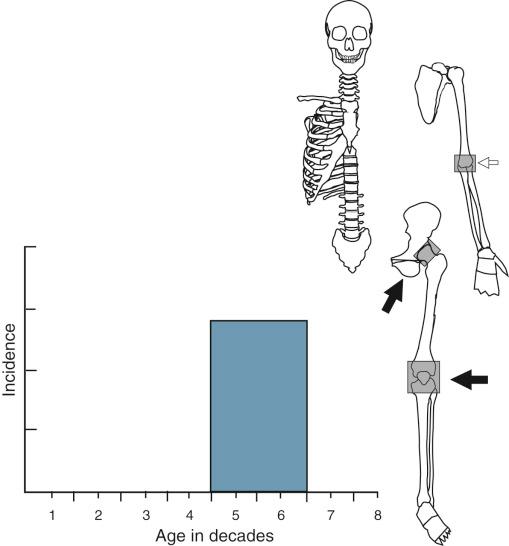
The clinical presentation consists of pain, swelling, and limitation of motion. The patient may have a history of symptoms lasting several months to several decades, but usually symptoms have persisted for several years, with the average being 5 years.
If the process is well developed (i.e., sufficient mineralization of the cartilaginous matrix has occurred), the changes shown on plain radiographs are characteristic, and the diagnosis can be established preoperatively. However, in approximately 10% of synovial chondromatoses, no calcifications can be documented on plain films. In typical cases involving a major joint, synovial chondromatosis presents as multifocal, articular, or periarticular nodules with stippled or ringlike calcifications ( Figs. 20-2 to 20-5 ). The level of mineralization gradually increases if the lesions are untreated. Older lesions are heavily calcified and easy to recognize on radiographs. Superimposition of enchondral ossification is associated with the development of linear calcifications. The nodules may eventually develop ringlike or eggshell-like calcifications with central lucencies ( Fig. 20-2 ). These structures correspond to well-developed ossified nodules that are composed of a shell of bone with a central area mimicking a medullary cavity. Occasionally the involvement may be quite extensive, and the disease may pursue an aggressive clinical course ( Fig. 20-2 ). In such cases, there is extensive involvement of tendons, multiple joints, or both tendons and joints in the same anatomic region. Bone erosion can be present and is not an indication of aggressive behavior. Computed imaging techniques, especially magnetic resonance imaging, are helpful in identifying the lesion in its early stages when there is insufficient mineralization to be documented in conventional radiographs. In later stages, these techniques provide the means to evaluate the extent of involvement of the joint and its adjacent structures ( Figs. 20-4, 20-6, and 20-7 ). T1-weighted images typically show a punctate signal void in the lesion involving the joint capsule. However, T2-weighted images show signal enhancement and may show the lesion to have a multinodular architecture. Lesions involving smaller joints become symptomatic in earlier stages and may show discrete, ill-defined calcifications or no calcification on plain radiographs ( Figs. 20-8 and 20-9 ). At the other end of the spectrum are long-lasting lesions that present as a consolidated, heavily calcified mass.
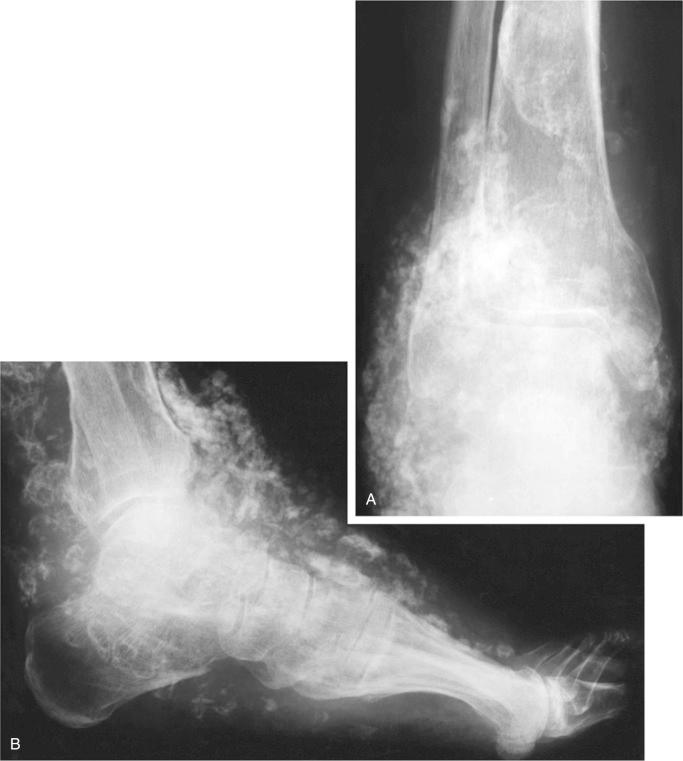
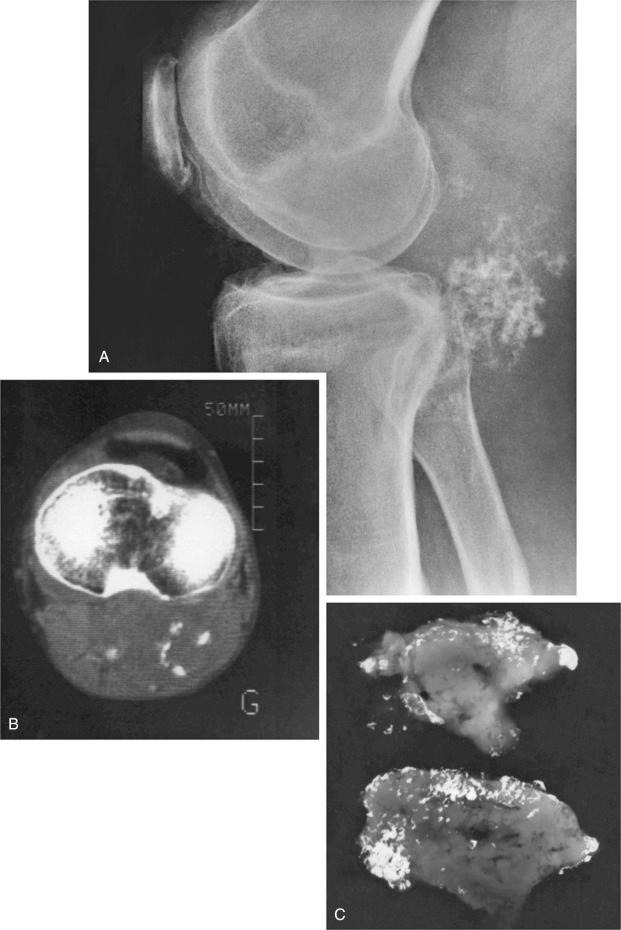
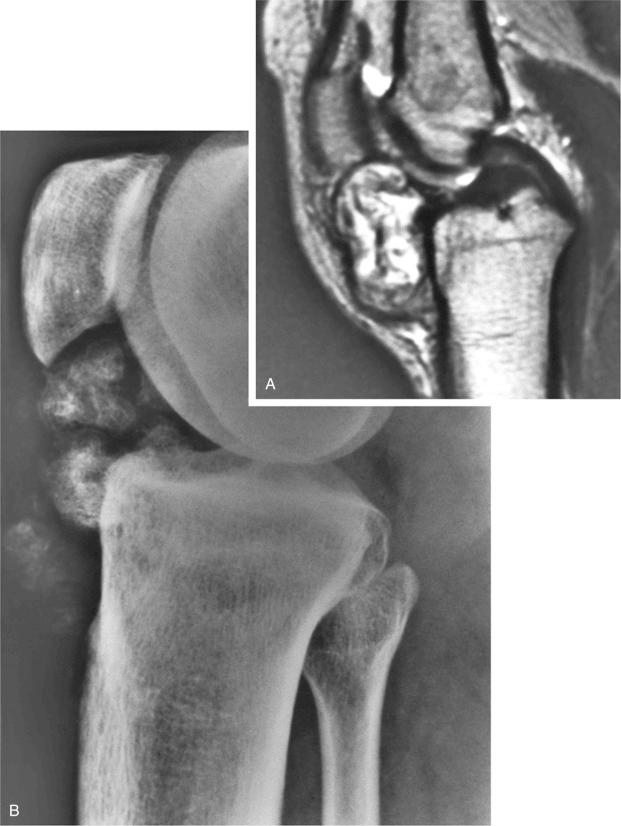
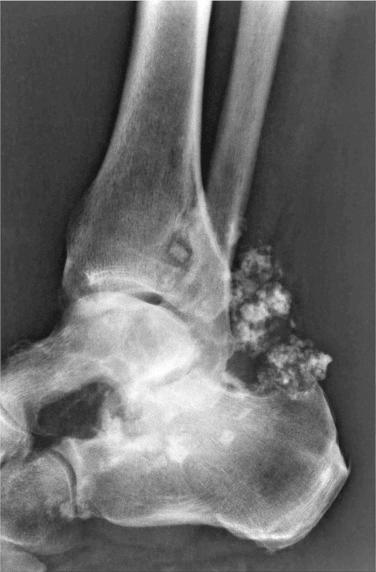
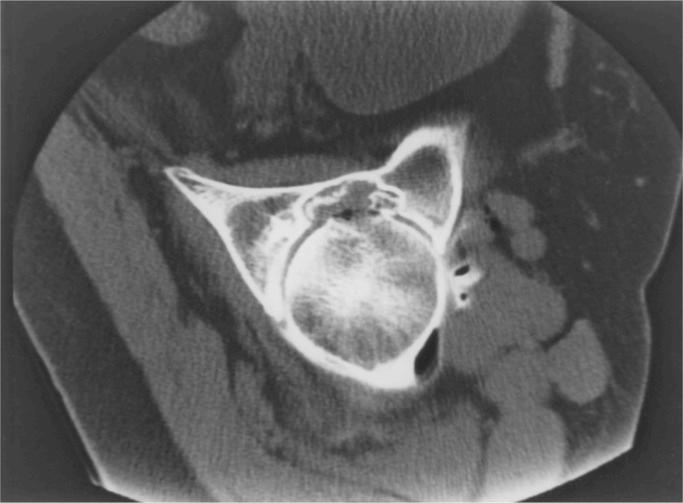
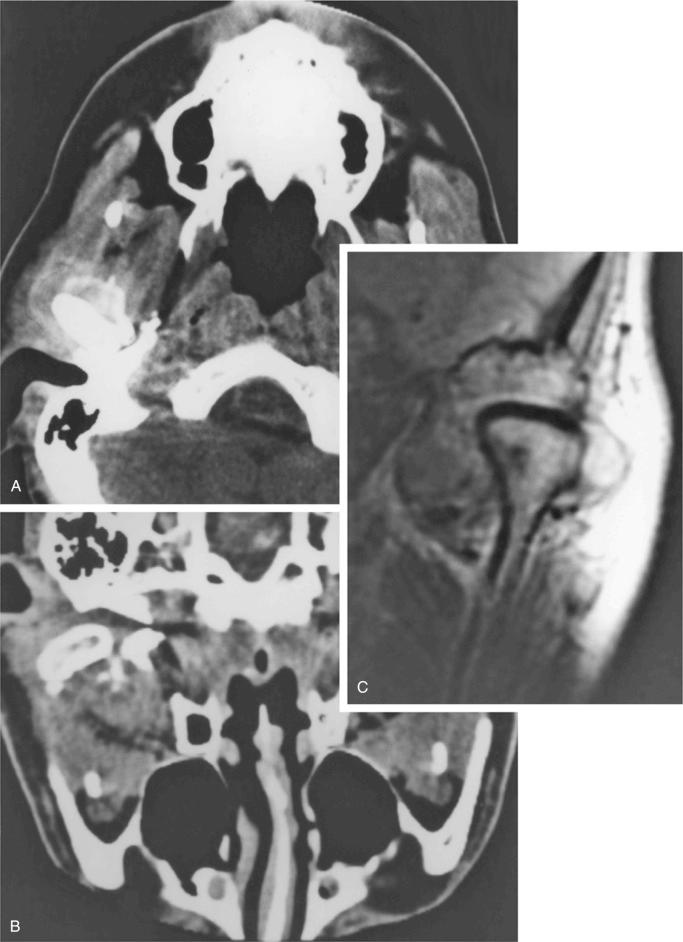
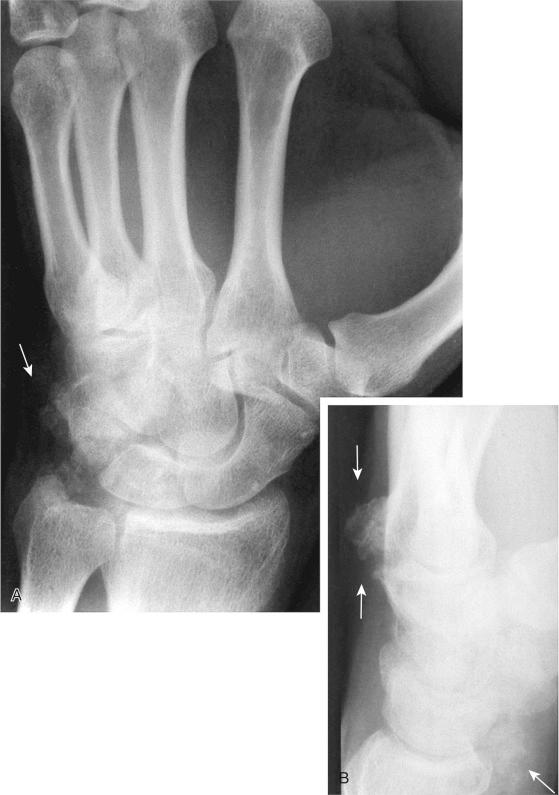
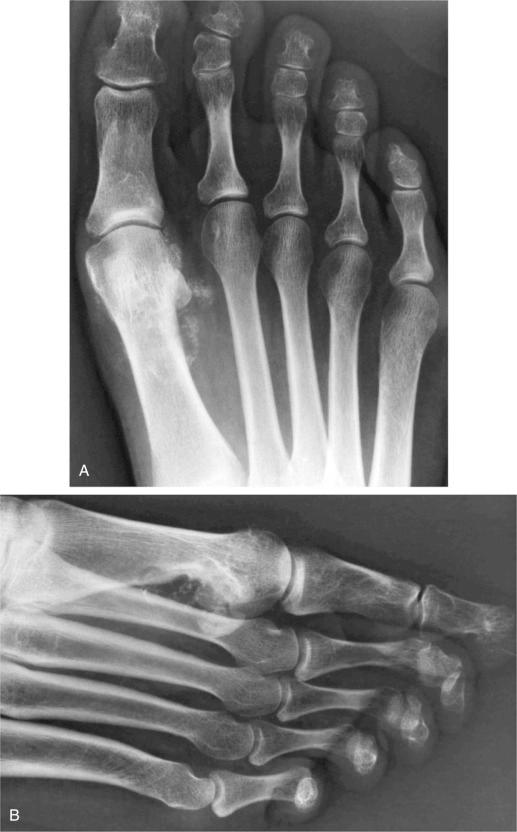
In advanced cases, the synovium is diffusely involved and may be studded with multiple cartilage nodules ( Fig. 20-10 ). Each cartilage nodule ranges in size from a small focus (<1 mm) that requires a magnifying glass to be seen to a larger lesion measuring more than 1 cm in diameter. In well-established, diffuse lesions, there are multiple free cartilaginous nodules, and the joint space occasionally is packed with loose bodies that range in size from 1 mm to 1 to 2 cm ( Fig. 20-10 ). In addition to individual nodules focally, larger cartilaginous areas represent coalescent smaller nodules of cartilage. These larger cartilaginous masses have multinodular (granular) surfaces, and their multifocal origin can still be seen on cut surface. Occasionally in long-standing cases, the adjacent bursae or tendons may be involved. On the basis of gross features, synovial chondromatosis can be divided into two forms: diffuse and localized. The diffuse form is characterized by multiple nodules that involve almost the entire synovium of the joint. In the localized form a discrete mass is present and represents a coalescence of individual nodules of metaplastic cartilage ( Fig. 20-11 ). In rare cases a nodular form of synovial chondromatosis can have a configuration of a polypoid pedunculated mass protruding into the joint space. The process typically involves synovial membranes of the joint capsule. Exclusively extraarticular cases are rare. Extraarticular involvement is associated more often with an articular form.
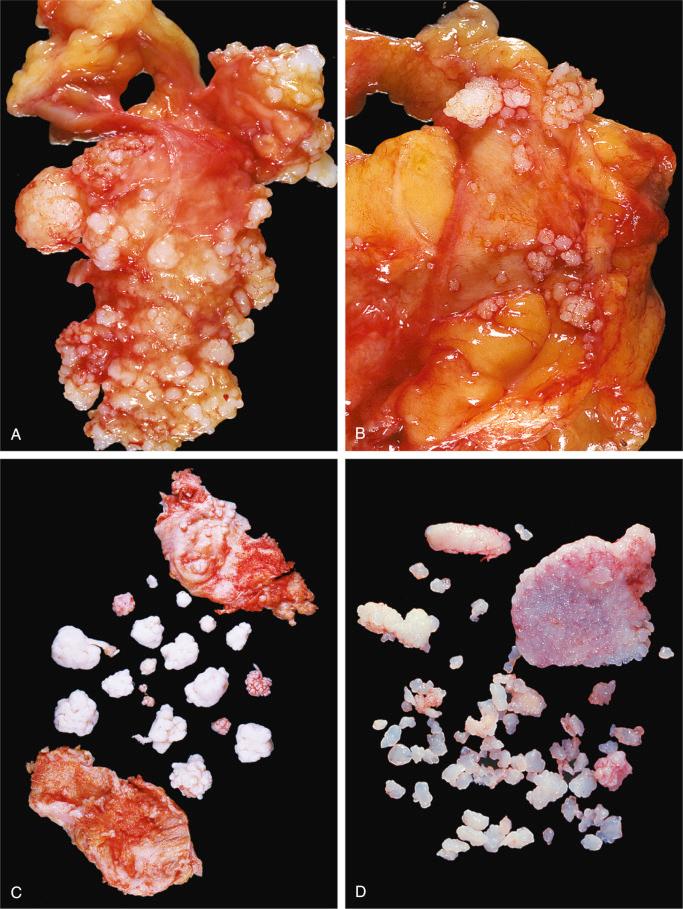
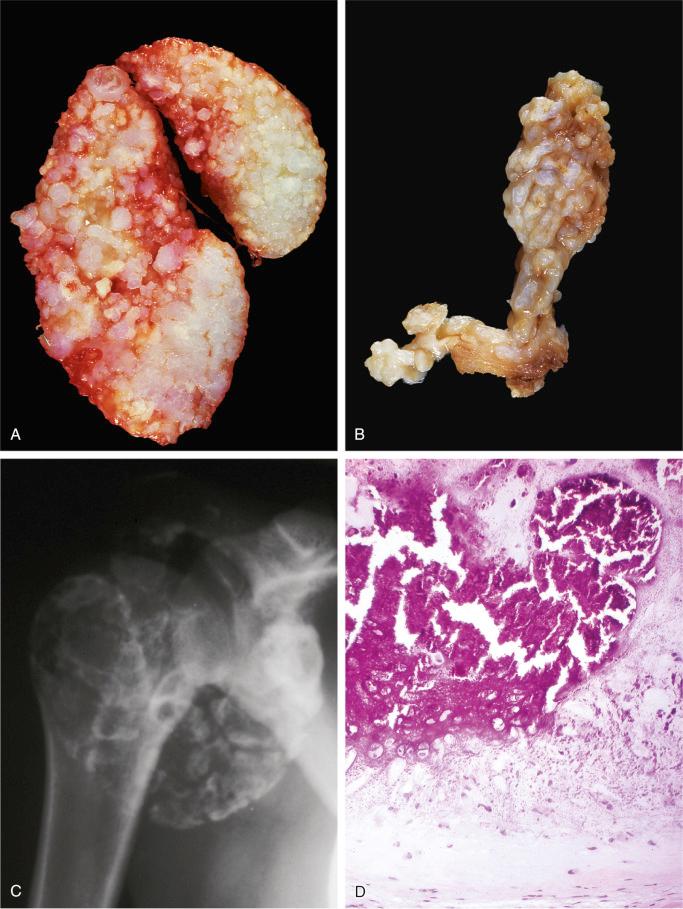
Fully developed synovial chondromatosis consists of multiple, well-demarcated nodules of cartilage with hyaline or myxoid features ( Fig. 20-12 ). Early lesions are composed of ill defined hypercellular nodules composed of chondroblastic cells with minimal matrix formation ( Figs. 20-13 and 20-14 ). In typical cases the cartilage cells form loose clusters, but a uniform distribution of cartilage cells can also be seen. The cellularity of cartilage nodules is often increased. The nuclei of cartilage cells have open chromatin and small nucleoli and may exhibit significant nuclear atypia ( Figs. 20-15 to 20-17 ). Binucleated or larger cartilage cells are frequently present. The microscopic features of cartilage atypia may be compatible with those seen in grade 1 and 2 chondrosarcomas if taken out of context of a metaplastic synovial condition. These features should not be considered as indicative of malignant transformation and cannot be correlated with a more aggressive clinical behavior of the disease.
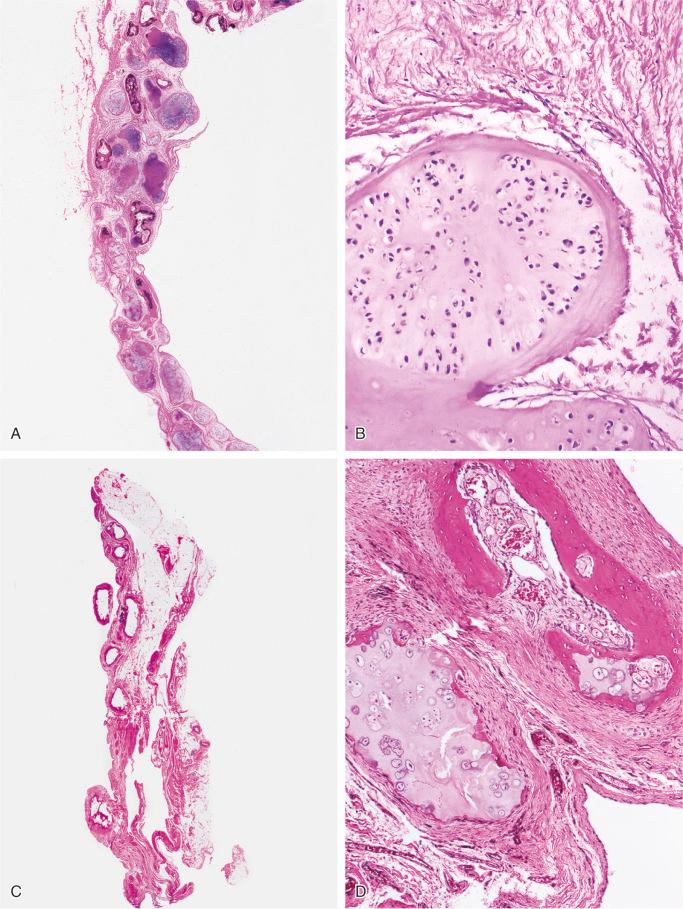
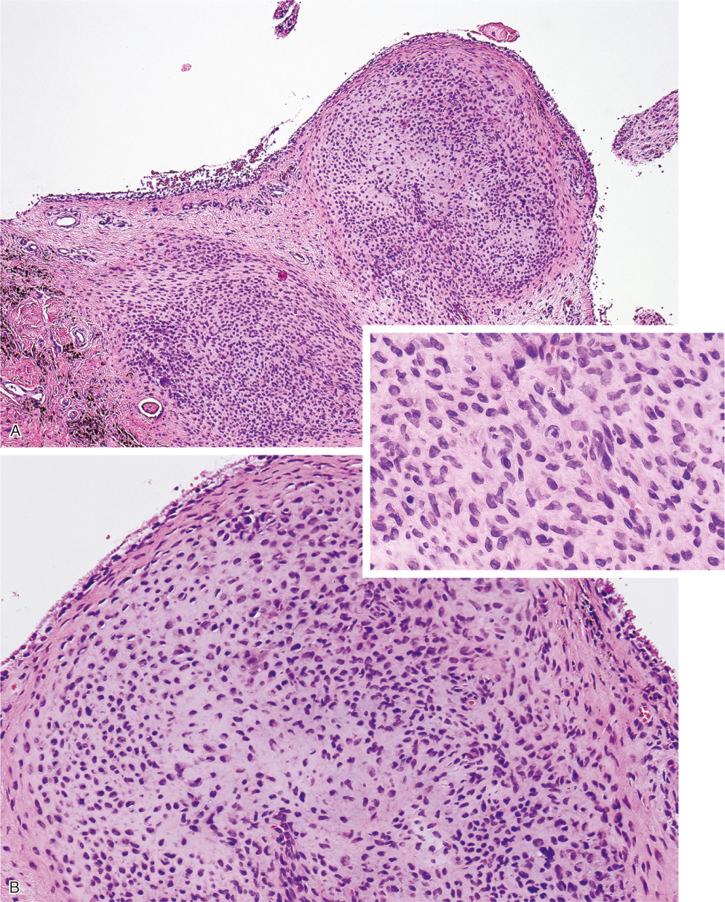
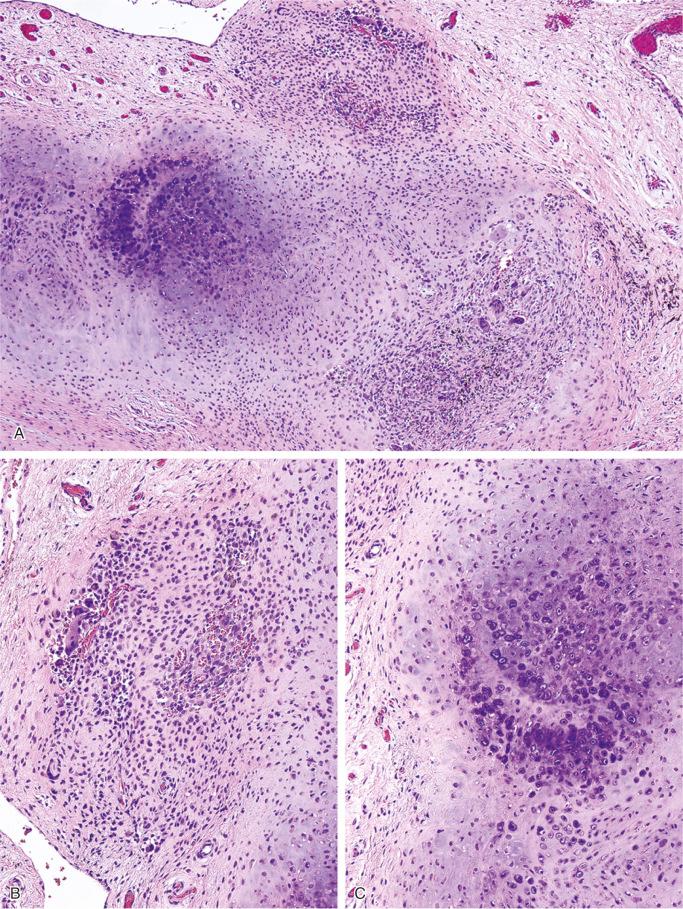
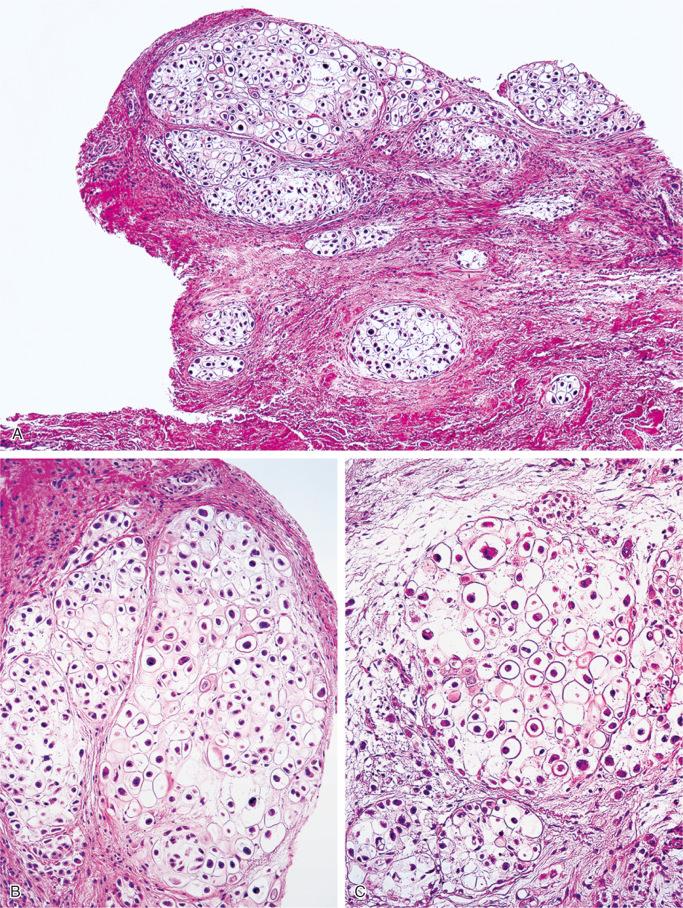
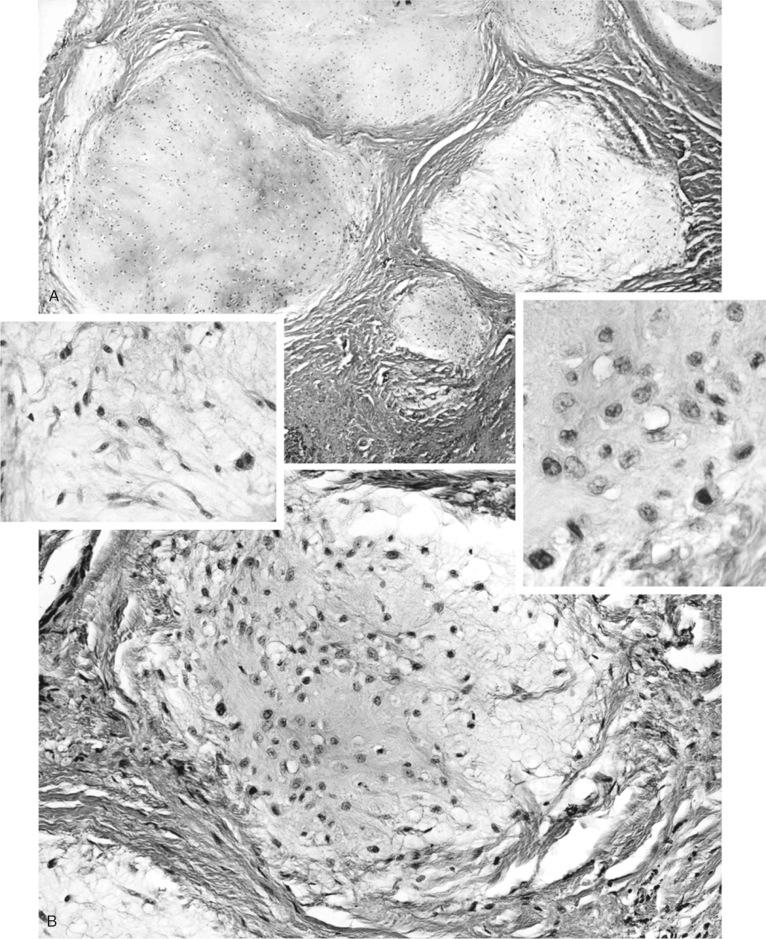
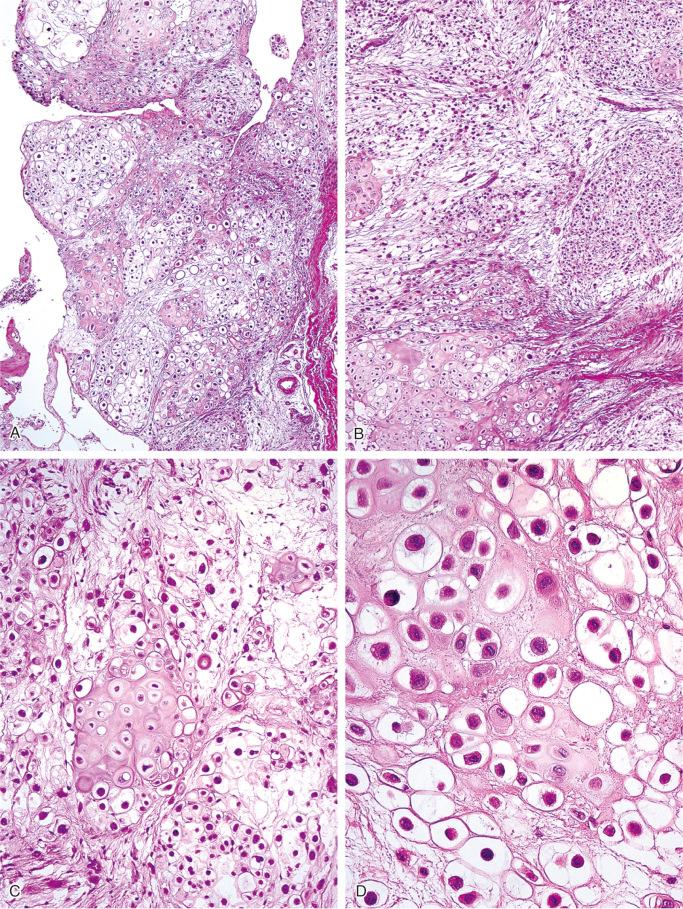
The development of cartilage nodules in this metaplastic process is somewhat similar to normal phases of cartilage development. However, the majority of patients have a long history of symptoms when they are first seen. Therefore the early phases of this process are rarely seen. The earliest phases of synovial cartilage metaplasia are most frequently seen in smaller joints, such as the temporomandibular joint or the small joints of the acral skeleton, in patients with a short history of symptoms. In the earliest stages of synovial chondromatosis, small islands of cartilage cells with chondroblastic features form. Individual chondroblastic cells dispersed within the stromal tissue of the joint capsule also can be seen ( Fig. 20-18 ). Loosely arranged clusters of immature cartilage cells may exhibit myxoid or clear-cell features. Occasionally, larger, loose areas of cells with microscopically recognizable chondroblastic features can be seen within the soft tissue in the vicinity of more mature cartilage islands ( Fig. 20-19 ). These foci are present beneath the synovial lining and do not directly involve the synovium. Smaller, more densely packed foci of chondroblastic cells with dense eosinophilic cytoplasm and large hyperchromatic nuclei may also be present within well-established cartilage nodules ( Fig. 20-20 ). It is our impression that immaturity of cartilage cells is responsible for prominent atypia in a majority of cases. Rarely is the formation of cartilage nodules associated with prominent giant cell osteoclastic reaction ( Fig. 20-21 ).
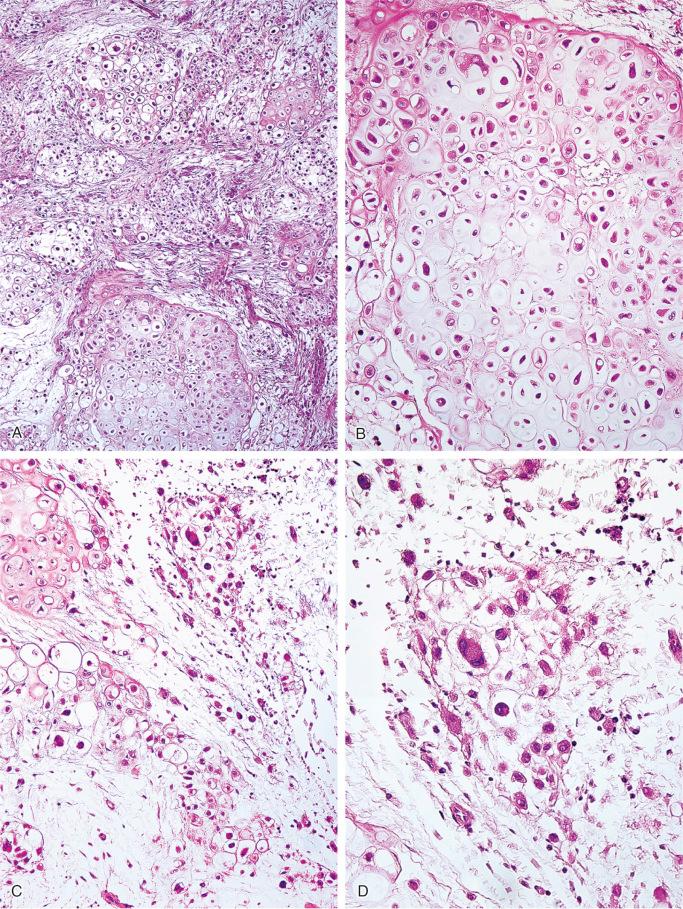
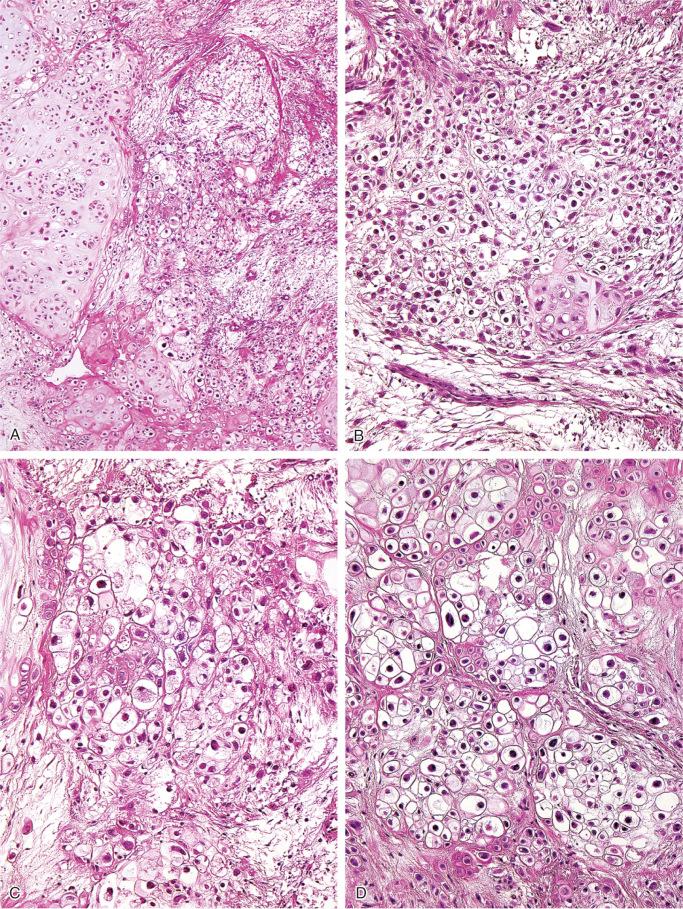
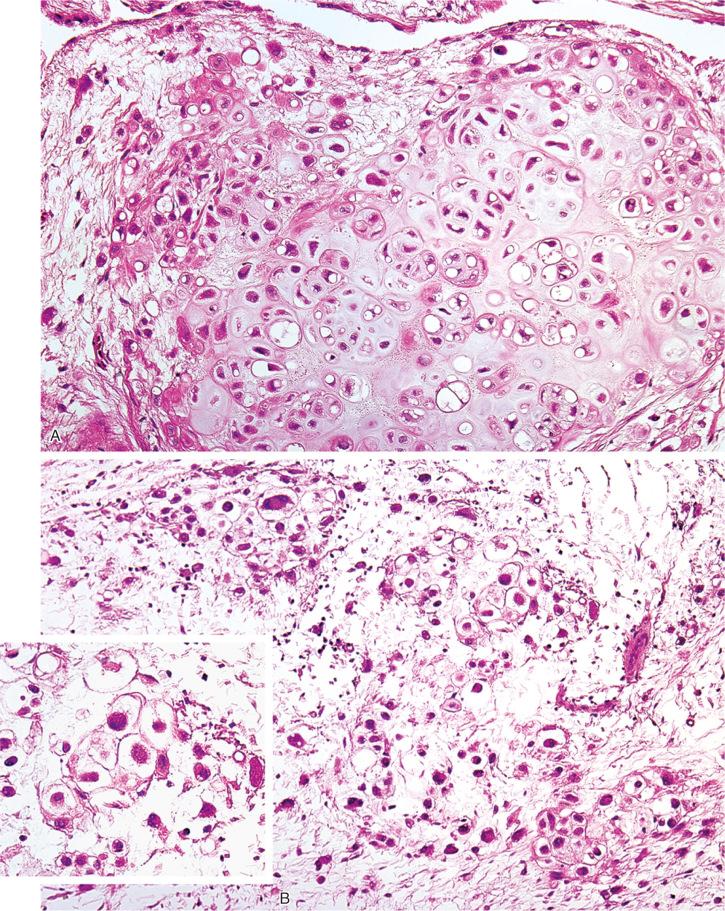
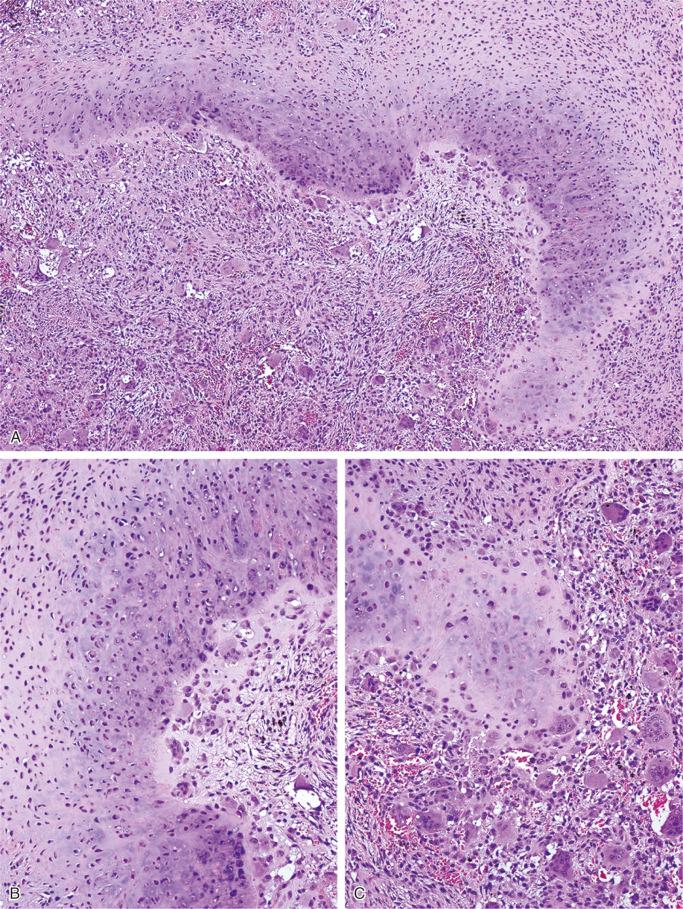
Enchondral ossification of cartilage nodules is a frequent feature of well-developed synovial chondromatosis. There are well-developed peripheral rings or eggshells of lamellar bone ( Fig. 20-12 ). Occasionally the nodules consist of well-formed rings of lamellar bone with a central, fatty bone marrow–like space. Lesions with well-developed enchondral ossification are also referred to as osteochondromatosis.
Lesions that present as a single cartilaginous nodule within the joint capsule are sometimes referred to as synovial chondromas. Single, isolated cartilage nodules are typically seen in smaller joints of the acral skeleton ( Fig. 20-22 ) or in the temporomandibular joint. These lesions typically show prominent mineralization of cartilage matrix. It is still controversial whether a single discrete nodule within synovium or periarticular soft tissue is a clonal neoplastic proliferation of cartilage cells (i.e., chondroma) or represents a localized unifocal variant of a metaplastic process (i.e., synovial chondromatosis).
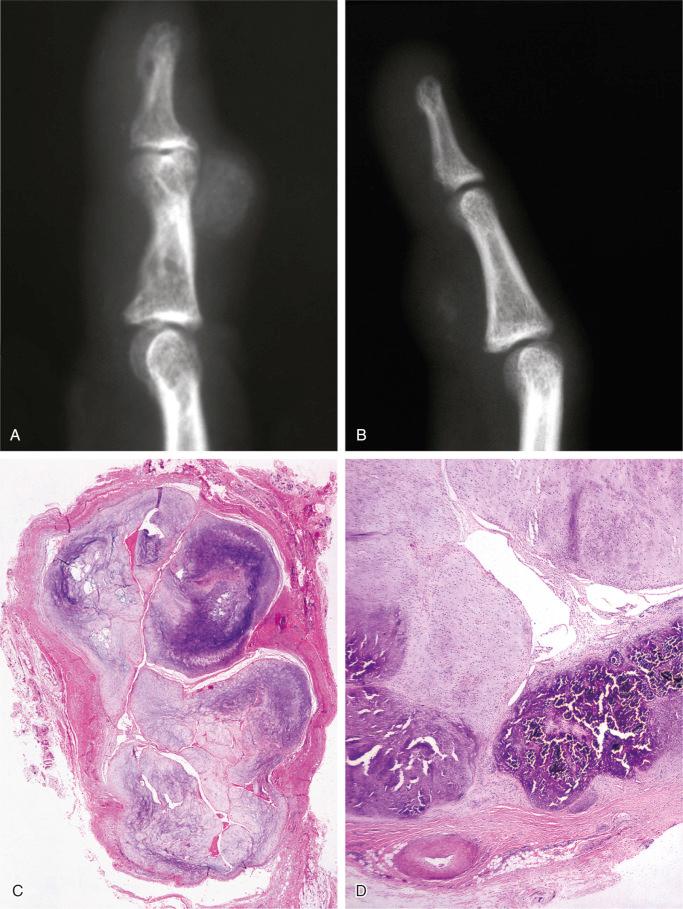
The most important consideration in differential diagnosis is chondrosarcoma. The cytologic atypia of cartilage cells is often worrisome and raises the suspicion of chondrosarcoma. The approach used to evaluate synovial chondromatosis is the same as that used to evaluate cartilage lesions of bone. Thus as with cartilage lesions, all clinical and radiographic findings should be considered.
First, rare but well-known secondary involvement of the joint by a chondrosarcoma of the adjacent bone, such as the femur or tibia, must be clinically and radiographically ruled out. This dilemma arises most frequently in evaluating hip lesions, in which the joint capsule may be secondarily involved by a chondrosarcoma of the adjacent pelvic and femoral bones. When the clinical, radiographic, and gross findings are consistent with the process confined to the joint capsule and space, the atypia of cartilage cells can be discounted as a feature of malignant transformation, and the lesion can be classified as synovial chondromatosis. However, these cases must be differentiated from extremely rare primary synovial chondrosarcoma or chondrosarcoma developing in synovial chondromatosis (see later section). In rare instances synovial chondromatosis may develop in a bursa overlying an osteochondroma. Such cases may, radiographically, mimic a secondary chondrosarcoma arising in the cartilaginous cap of the osteochondroma.
Become a Clinical Tree membership for Full access and enjoy Unlimited articles
If you are a member. Log in here